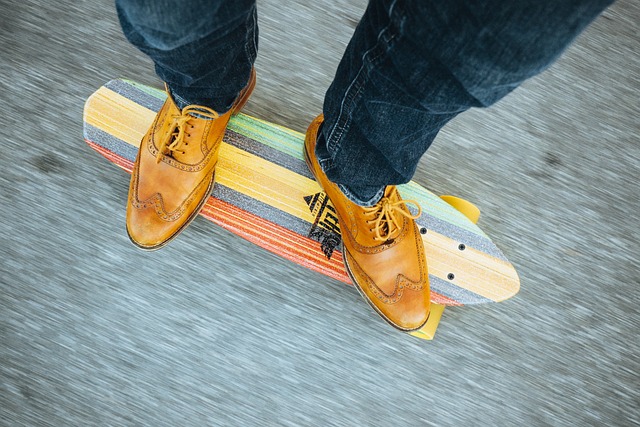Longboarding offers an exciting entry point into extreme sports for newcomers, providing a stable and accessible platform to learn fundamental techniques. Key considerations for choosing a suitable longboard include intended use, deck material (maple for strength & flexibility), and wheel size (larger for smoother rides). Starting gear should include boards designed for beginners (32-36 inches long), wheels suited to various surfaces, flat-soled sneakers with good traction, knee/elbow pads, and a helmet. Mastering balance, proper stance, turning, and carving are essential basics. Safety is paramount; gear up, practice in open spaces, and select boards tailored to skill level. Longboarding offers versatility from cruising to tricks, fostering confidence through progressive learning.
Dive into the world of longboarding with our comprehensive guide, designed specifically for beginners. From understanding the basics to choosing the right board and mastering essential techniques, this article covers everything you need to get started. Learn about various riding styles, safety precautions, and tips to build confidence quickly. Whether you’re new to longboarding or just starting, these insights will help you navigate your journey on wheels with ease.
Understanding Longboarding: A Beginner's Perspective

Longboarding is an exhilarating activity that has gained immense popularity among enthusiasts worldwide, and it’s a fantastic choice for beginners looking to explore the world of extreme sports. At its core, longboarding involves riding a board similar to a skateboard but on a longer, wider platform, offering stability and a smoother ride. This makes it accessible for those new to the scene, allowing them to focus on learning fundamental techniques without feeling intimidated.
For beginners, understanding the basic principles of longboarding is key. The freedom to glide down slopes and streets with ease captivates many newcomers. Longboards are designed to provide a unique blend of speed and control, enabling riders to carve turns, cruise comfortably, or even attempt simple tricks. With various deck shapes and wheel sizes catering to different styles, beginners can find the perfect setup to match their preferences and skill levels, ensuring a memorable and enjoyable learning curve.
Choosing the Right Board: Factors to Consider

When selecting a longboard suitable for beginners, several key factors come into play. First and foremost, consider your primary use case—whether it’s cruising around town, commuting to work, or performing tricks at the skate park. This will help narrow down the ideal board length and shape, with standard drop-through designs being popular among newcomers due to their stable and low riding position.
Material also plays a significant role in both durability and price point. Entry-level longboards often feature maple decks, known for their balance between strength and flexibility, while more advanced composites or fiberglass options offer enhanced performance at a higher cost. Additionally, keep an eye on wheel size; larger wheels (around 70mm) provide smoother rides over rough surfaces, making them ideal for beginners learning to maintain speed and control.
Essential Gear: What You Need to Get Started

Starting your journey with a longboard for beginners is an exciting endeavor, and having the right gear can make all the difference. The essential equipment includes a board designed specifically for newcomers, offering a balanced shape and smooth ride. Look for deck options that are typically between 32 to 36 inches long, providing stability without adding excessive weight. Additionally, choose wheels suitable for various surfaces; softer wheels are ideal for smoother rides on rough terrain, while harder wheels offer better control and speed on paved roads.
Don’t forget the importance of a good pair of shoes. Opt for flat-soled sneakers with adequate traction to prevent slips. Safety is paramount, so invest in knee and elbow pads, especially during initial attempts at tricks or navigating unfamiliar paths. These basic gear essentials will ensure a comfortable and secure learning experience as you master the art of longboarding.
Learning the Basics: Stance and Standing Techniques

For those new to longboarding, mastering the fundamentals is a crucial first step. One of the essential basics is understanding and adopting a proper stance. This involves positioning your feet on the board in a comfortable, balanced manner, with slightly bent knees for stability and control. Beginners should focus on keeping their weight evenly distributed across the board to ensure an upright, yet relaxed posture.
Additionally, learning basic standing techniques like pushing and carving is vital. Pushing teaches you how to generate speed and control your direction by shifting your weight forward. Carving involves leaning into turns, allowing for smooth, flowing movements across the pavement. These skills form the groundwork for more advanced maneuvers, making them indispensable for any longboarder just starting out on their journey.
Mastering Balance: Tips for Stability

Mastering balance is a fundamental skill for any longboarder, especially those new to the sport. It’s all about finding equilibrium and controlling your movements to stay steady on the board. For beginners, it might seem daunting, but with practice, you’ll develop a sense of stability. Start by focusing on your core muscles; strengthening them will help you maintain balance.
When learning, choose a suitable longboard for beginners—one that provides good stability and support. Practice on flat surfaces first, gradually progressing to inclines. Keep your eyes ahead, scan the path, and engage your legs to adjust your position as needed. Remember, it’s normal to wobble at first; stay patient, consistent practice will lead to significant improvement in your balance.
Turning and Carving: Introduction to Maneuvers

For those new to longboarding, learning basic maneuvers like turning and carving is a fantastic place to start. Turning involves guiding your board along a curved path, while carving refers to making smooth, flowing turns that resemble the contours of ocean waves.
Beginners should focus on mastering these techniques using simple practices. Start with small, controlled turns in a safe, open space. Gradually increase speed and radius as comfort levels improve. Remember, proper stance and weight distribution are key to executing clean, successful turns and carvings on your longboard for beginners.
Practicing Safety: Precautions for Beginners

When starting out with a longboard for beginners, prioritizing safety is paramount. Always wear protective gear, including a helmet and knee/wrist pads, to mitigate risks associated with falls. Choose a longboard suitable for your skill level and riding style; decks with softer shapes or pre-drilled holes can make mounting trucks and wheels easier for novices.
Practice in an open, flat area away from traffic and pedestrians. Learn how to properly control speed and stop using the board’s brakes or foot breaks. Mastering these basics will build confidence and lay a solid foundation for more advanced longboard techniques as you progress on your longboard journey.
Exploring Different Riding Styles

When it comes to finding your riding style on a longboard for beginners, there’s a world of possibilities to explore. Many new riders stick with a classic cruising style, enjoying the smooth glide and ease of navigation. This is an excellent way to start, as it allows you to get comfortable with balancing and steering at various speeds.
However, the beauty of longboarding lies in its versatility. You might also want to experiment with carving, which involves making fluid, flowing turns much like surfing the waves. Alternatively, freeride or freestyle techniques can add a whole new dimension to your riding experience, with tricks, jumps, and dynamic maneuvers that will challenge you and keep things exciting.
Building Confidence: Advancing from Fundamentals

For those new to longboarding, building confidence is a crucial step in their journey. Starting with mastering the fundamentals ensures a solid base and fosters a sense of accomplishment. As beginners gain proficiency in basic skills like turning, carving, and maintaining balance, they gradually advance to more complex maneuvers. This progressive learning curve not only boosts self-assurance but also allows riders to appreciate the subtle nuances of longboarding.
By consistently practicing fundamental techniques, beginners can build a strong foundation that will enable them to attempt more challenging tricks with ease. This progression encourages persistence and a growth mindset, which are essential for mastering any skill, especially in a dynamic activity like longboarding.
